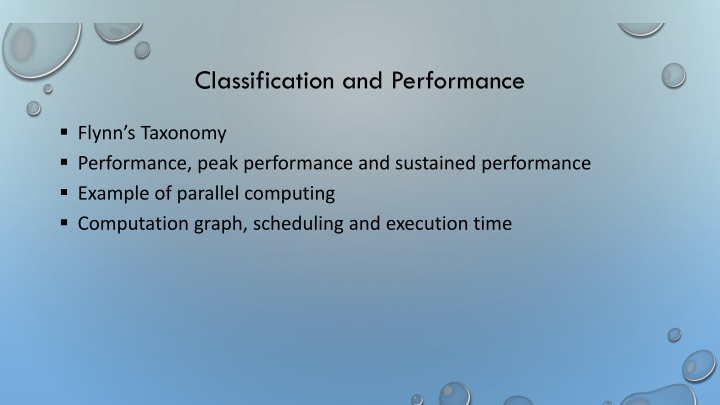
Flynn's Taxonomy in Parallel Computing
Flynn's Taxonomy categorizes parallel computing systems based on instruction and data streams, with classifications including SISD, SIMD, MISD, and MIMD. SISD involves one instruction on one data, SIMD utilizes a single control unit with multiple processing units, MISD is rare, and MIMD encompasses multiple instruction and data streams. Examples and applications of each type are discussed, shedding light on their unique characteristics and performance capabilities.
Download Presentation

Please find below an Image/Link to download the presentation.
The content on the website is provided AS IS for your information and personal use only. It may not be sold, licensed, or shared on other websites without obtaining consent from the author. If you encounter any issues during the download, it is possible that the publisher has removed the file from their server.
You are allowed to download the files provided on this website for personal or commercial use, subject to the condition that they are used lawfully. All files are the property of their respective owners.
The content on the website is provided AS IS for your information and personal use only. It may not be sold, licensed, or shared on other websites without obtaining consent from the author.
E N D
Presentation Transcript
Classification and Performance Flynn s Taxonomy Performance, peak performance and sustained performance Example of parallel computing Computation graph, scheduling and execution time
Flynns Taxonomy Computing is basically executing instructions that operate on data. Flynn s taxonomy classifies the system based on the parallelism in instruction stream and parallel in data stream. o single instruction stream or multiple instruction streams. o single data stream or multiple data streams.
Flynns taxonomy Single Instruction Single Data (SISD) Single Instruction Multiple Data (SIMD) Multiple Instructions Multiple Data (MIMD) Multiple Instructions Single Data (MISD)
SISD At one time, one instruction operates on one data oTraditional sequential architecture, Von Neumann architecture.
SIMD Single control unit and multiple processing units. The control unit fetches an instruction and broadcast control to all processing units. The instruction operates on different data. o Can achieve massive processing power with minimum control logic o SIMD instructions allow for sequential reasoning.
SIMD Exploit data-level parallelism o Matrix-oriented scientific computing and deep learning applications o Media (image and sound) processing Vector machines, MMX, SSE (Streaming SIMD Extensions), AVX (Advanced Vector eXtensions), GPU
MISD Not commonly seen, no general purpose MISD computer has been built. Systolic array is one example of an MISD architecture.
MIMD Multiple instruction streams operating on multiple data streams o MIMD can be thought of as many copies of SISD machine. oDistributed memory multi-computers, shared memory multi-processors, multi-core computers.
Flynns Taxonomy Type Instruction Streams Data Streams Examples SISD 1 1 Early computers, Von Neumann architecture, turing machine SIMD 1 N Vector architectures, MMX, SSE, AVX, GPU MISD N 1 No general purpose machine, systolic array MIMD N N Multi-core, multi-processor, multi-computer, cluster
Modern classification (Sima, Fountain, Kacsuk) Based on how parallelism is achieved o Data parallelism: same function operating on many data o Function parallelism: performing many functions in parallel Control parallelism, task parallelism depending on the level of the functional parallelism. Parallel architectures Data-parallel architectures Function-parallel architectures
Functional-parallel architectures Function-parallel architectures Instruction level Parallel Arch (ILPs) Process level Parallel Arch (MIMDs) Thread level Parallel Arch Superscalar processors VLIWs Pipelined processors Shared Memory MIMD Distributed Memory MIMD
Modern classification (Sima, Fountain, Kacsuk) BY OPERATING ON MULTIPLE DATA: DATA PARALLELISM BY PERFORMING MANY FUNCTIONS IN PARALLEL: FUNCTION PARALLELISM CONTROL PARALLELISM, TASK PARALLELISM DEPENDING ON THE LEVEL OF THE FUNCTIONAL PARALLELISM. Parallel architectures Data-parallel architectures Function-parallel architectures
Performance Time and performance: Machine A is n times faster than Machine B if and only if ????(?) ????(?)= ? Program execution time = ???????????? ?????? ??????????? ???? ????? ??????? (CPI) (cycle time) ??? ????? ???? can be approximated as instruction per second (IPS). o In a system with variable instruction cycles, IPS is program dependent this metric can be misleading, and not very useful.
Performance MIPS (millions instructions per second) vendors sometimes report this value as an indication of the computing speed. It is not a good performance metric. MFLOPS (million floating-point operations per second): This is more meaningful when it is the measured time for completing a complex task. FLOPS = FP ops in program/execution time For CPU (or GPU), vendors use this formula ????? ?????? ????? ???? ????? ????? = ??????? ?????
FLOPS UNITS Units Order 103 106 109 Comments: KFLOPS (kiloFLOPS) MFLOPS (megaFLOPS) GFLOPS (gigaFLOPS) Intel i9-9900K CPU at 98.88GFLOPS, AMD Ryzen 9 3950X at 170.56FLOPS 1012 TFLOPS (teraFLOPS) Nvidia GTX 3090 at 36 TFLOPS (2002 No. 1 supercomputer NEC Earth Simulator at 36TFLOPS) 1015 1018 PFLOPS (petaFLOPS) EFLOPS (exaFLOPS) This is the next milestone for supercomputers (exa-scale computing). We are almost there: Fugaku at 0.442 EFLOPS You can find the FLOPS for up-to-date CPUs at https://setiathome.berkeley.edu/cpu_list.php
Peak and sustained performance The FLOPS value reported by vendors is the peak performance that no program can achieve. Sustained FLOPS is the FLOPS rate that a program can achieve over the entire run. Peak FLOPS is usually much larger than sustained FLOPS ????????? ????? ???? ????? o?????????? ???? = A set of standard benchmarks are there to measure the sustained performance o LINPACK for supercomputers
Parallel computing and parallel programming Parallel computing: using multiple processing elements in parallel to solve problems more quickly than with a single processing element. o Fully utilize the computing power in contemporary computing systems. Parallel programming: o Specification of operations that can be executed in parallel o A parallel program is decomposed into sequential subcomputations (tasks) o Parallel programming constructs define task creation, termination, and interaction.
Parallel programming example See lect2/sum.cpp and lect2/sum_omp.cpp o #pragma omp parallel sections specifies task creation and termination o #pragma omp section specifies the two tasks in the program. o Notice that the parallel program runs slower when the array size is small. o lect2/sum_omp.cpp consists of four sub-tasks. A: the sequential part before the parallel region B, C: the two parallel sub-tasks D: the part after the parallel sub-tasks join back. A B C D
Parallel programming example Notice that this parallel program is non-trivial sum T[0] The calculation of sum in the loop has dependency inside. + T[1] + To overcome that, o Decompose the problem into two tasks, each compute partial sums T[size-1] + o Combine the results to get the final answer
Modeling the execution of a parallel program The execution of a parallel program can be represented as a computation graph (CG) or parallel program dependence graph that allows for reasoning about the execution. o Nodes are sequential subtasks o Edges represent the dependency constraints Both control dependency and data dependency are captured. o A CG is a directed acyclic graph (DAG) since a node cannot depend on itself. CG describes a set of computational tasks and the dependencies between them.
Computation graph example The computation graph for lect2/sum_omp.cpp A Node A must be executed before Node B if there is a path from A to B in the graph CG can be used as a visualization technique to help us understand the complexity of the algorithms. CG can also be used as a data structure for the compiler or the system to schedule the execution of the sub-tasks. B C D
Complexity with computation graph Let T(N) be the execution time of node N Work ?? = ? ?? ??? ? is the total work to be executed in CG o execution time with a single processor Let span(CG) be the longest path in CG when adding the execution time of all nodes in the path. o span(CG) is the smallest possible executable for the CG regardless of how many processors are used! o Note that CG is a DAG. CG s degree of parallelism is defined as parallelism = ????(??) ????(??). The parallelism of a computation provides a rough estimate of the maximum number of processors that can be used efficiently. o Consider two situations: parallelism = 1 and parallelism = N
Let the time for each node be 1, compute the work, span, and parallelism for the following two computation graphs A A C D B B C D E F E F G G
What are the work, span and parallelism of the following CG? A: 1 B: 2 C: 4 F: 1 G: 2 D: 1 E: 2 H: 1 I: 2
Scheduling of a computation graph Assume each node takes 1 time steps. A A task can be allocated only when all of its predecessors have been executed. Task scheduling: Time step P0 P1 1 A - 2 B C 3 D E 4 H F 5 G - 6 I - 7 J - B C D E F G H I J
Scheduling of a computation graph A Another schedule: better than the previous one B C Task scheduling (2 processors) Time step 1 A - 2 B C 3 D E 4 F G 5 H I 6 J - P0 P1 D E F G H I J
Greedy schedule A greedy schedule is one that never forces a processor to be idle when one or more nodes are ready for execution. A node is ready for execution if all its predecessors have been executed With one processor, let ?1?? be the time to execute CG. o With any greedy schedule ?1?? = ????(??). With an infinite number of process, let ? ?? be the time to execute CG with an infinite number of processors. o With any greedy schedule, ? ?? = ????(??)
Greedy schedule With P processors, let ???? be the execution of a schedule for CG. For any greedy schedule: o???? ????(??) ? o???? ???? ?? oHence, ???? max(???? ?? ,???? ?? ) ?
Greedy schedule For any greedy schedule: o ???? ???? ?? o A step is complete when all P processors are used, incomplete otherwise o Number of complete steps ????(??)/? o Number of incomplete steps ????(??) o Total steps ???? ?? ? + ????(??) + ???? ?? ? oGraham, R. L. Bounds on Multiprocessing Timing Anomalies. SIAM Journal on Applied Mathematics 17, no. 2 (1969): 416 29.
Greedy schedule Combine the results: max(???? ?? ,???? ?? ) ???? ???? ?? + ???? ?? ? ? Any greedy scheduler achieves ???? that is within a factor of 2 of the optimal.
Summary Flynn s taxonomy: SISD, SIMD, MISD, MIMD Performance metrics MIPS, GFLOPS. Peak performance and sustained performance. Computation graph: describe the dependencies between tasks in a parallel computation. Parallelism = Work(G) / span(G), an approximation of the number of processors that can be used effectively in the computation. Greedy scheduler assigns tasks to processors whenever a task is ready and a processor is available. The execution time with a greedy scheduler is at most 2 times that of the optimal scheduler.






















